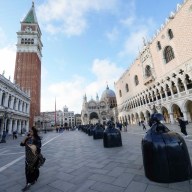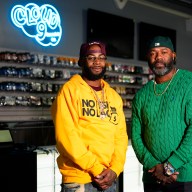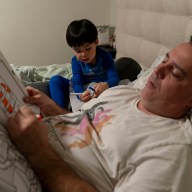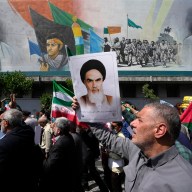Adam Rapp is the director and playwright of “Animals & Plants,” one half of the two-act “HotelMotel” experience produced by The Amoralists (through Sept. 19). This site-specific show runs alongside Derek Ahonen’s “Pink Knees On Pale Skin,” and both take place within the lobby of the Gershwin Hotel (7 East 27th Street). Rapp opens up with us about taking his play down from the stage and the future of immersive theater in NYC.
Did you write “Animals & Plants” specifically for the unique hotel setting?
It was written 11 years ago, and it was originally produced at American Repertory Theater in Cambridge. To be honest, I didn’t like that first production. So when I started directing my work a few years later, I vowed that I would hold onto it and protect it until I found the right people. So when these guys at The Amoralists approached me about doing something that took place in a hotel room, I said: “Well I have a play that takes place in a motel room, how can we make that work?” So, theoretically, I said I would just float that motel room inside the Gershwin Hotel room and we would call it HotelMotel so we could find a way to change the vocabulary a little bit and change the geography and maybe give the audience an interesting journey. Because Derek sets his play directly in the Gershwin, and he wrote it for that space. They wanted to work with me again because we had done something last fall, and I thought they had the personnel to play those parts, with William Apps and Matt Pilieci. And it just seemed like a really great fit.
Did the script or direction take much adaptation?
Not necessarily. When I actually walked into the space and I saw how it wasn’t necessarily like a classic hotel room – I think it’s an old library that they divided up – and it feels more like you’re in some sort of … strange little foyer/lounge/bar/mini-ballroom or something – I thought it would be really cool if I could contract the size of the space and make the audience the walls of the motel. Because when I conceived of the play the first time, I just thought the audience would be watching it in a fourth-wall experience where they would be in a proscenium and experiencing the play in that classic way. But when they brought me the idea of working at the Gershwin, I thought: “Well let’s surround the action and make the audience the walls.” So I did adapt it sort of philosophically. … It needed to be contextualized in that way.
There’s the character Buck [Brian Mendes] who introduces the play and steps in and out of the play and becomes more and more savage and magical. That was a very, very small character when we started the process. But the more we kept exploring the hauntedness of the room, and the backstory between Buck and Cassandra [Katie Broad], it just felt like there was this sort of spirit world that kept glimmering. When [Mendes] got involved and came into the process and rehearsals, I said try anything, walk through walls, be a nuisance and find out what’s there for Buck. And that became a really big part of this production that I really fell in love with early on. … The way that he was haunting the play just got more and more specific. And that was a big, big discovery.
I feel like the script is something that’s kind of a template or blueprint. And then as a director I want to get into the rehearsal room and have as much fun as possible and play and see what the actors bring. I used to be very repressed about like, discovering stuff. I just thought the script was the script and the actors should be playing the actions written in the script. And as I’ve gotten older – and a little more experienced and a little less concerned with being great or something – I’ve had a lot more fun. And I think the worlds that I’ve been involved in with in my plays have gotten a lot more interesting to me. The process has been a lot richer because of it.
Your show is very surreal. In that sense it contrasts sharply with “Pink Knees On Pale Skin.” How do you think the works juxtapose?
Derek creates a very realistic world where the events are happening right in front of you. And it’s really happening, and it’s in real time, and you’re really at the Gershwin Hotel, and Dr. Sarah Bauer is really conducting this experiment – this orgy counseling. That’s the bargain that Derek makes with the audience when they come in. Now within that, I think there are themes that are really interesting, like this notion of otherness. Is my wife the person I thought she was? What’s alienating in a relationship? My husband cheated on me, how am I going to negotiate that spiritually?
And suddenly with “Animals & Plants,” there’s this marriage that exists between this young girl and this violent man. And I think that [the two shows] speak to each other … not in any explicit way you could write down in a term paper and make a lot of sense about. But the two plays sort of have this thing about: Who am I in this moment? I think Dantly [Apps] in my play is struggling in a very existential way. In Derek’s play there’s a similar kind of crisis with identity. Are you who I thought you were? Even Dr. Sarah Bauer at the end … there’s this whole alien self that she can’t negotiate. She can solve all these other people’s problems but she has this disastrous mess of her own that she can’t get through. In those ways, I think the two plays actually speak to each other; otherwise, I think that they’re interesting in that they’re wildly different. … I’d like to think that thematically, they resonate.
Do you think with NYC theatergoers being so receptive to site-specific shows, it’s going to continue to be a trend?
I saw “Sleep No More” twice, and I had a pretty incredible experience both times – very different experiences. I think it’s really beautiful how they allow you to enter the space and create your own narrative. “The Tenant” by Woodshed Collective [is] similar; you walk through the rooms where action is taking place, and it’s in this old church. I’m really excited to see that, too. I’m getting more and more interested in how live theater can happen in unconventional spaces. I think the most exciting thing about it is that it crushes the safety of the proscenium; it allows you to wander into a room and be within arm’s reach of the actors. It puts the smell of the room right in your nostrils. It almost makes you complicit in the action in a more intense way. I like the thought of sitting really, really close. I like the idea of happening upon something. There’s a whole culture of safety and expectation that’s built into [conventional theater, while nontraditional theater] disarms that and opens you up and challenges you at least. So I think it’s a good, healthy trend – and I hope it continues to mix things up for the New York theater world.
















